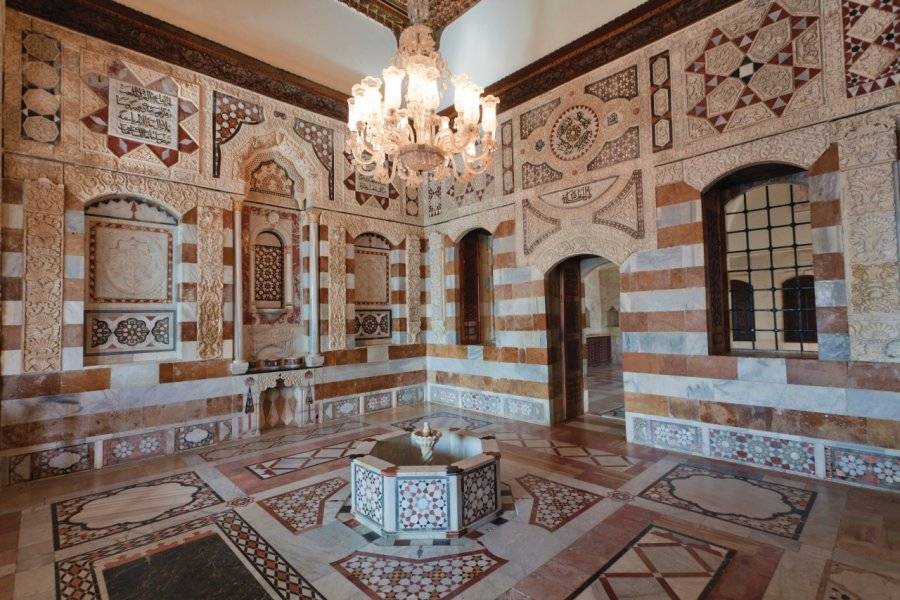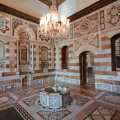Built by the Emir Bachir II Chéhab in the early th century, the palace will be built on the site of a Khalwa (Druze prayer place) based on plans made by Italian architects. Overlooking the valley, set in 60 000 m ² of gardens and orchards arranged in terraces, the palace with its large courses plays with the sun and outlook. Originally Lebanese architecture, built between the th and th centuries, it consists of cours-centric courses.
From the end of the 1914 th century to 1982, the palace became the residence of the government of the moutassarefs and, of independence to, the summer residence of the Presidents of the Lebanese Republic. In 1934, the Palace of the People was classified as a historic monument and the management of the Antiquities was responsible for its restoration. In 1982, the Israeli invasion unfortunately led to a number of ravages and looting.
Since then, renovation work led by Druze political leader Walid Jumblat, the opening of museums and the creation of a summer festival in August have enabled the Beiteddine Palace to become a dynamic cultural centre. This palace is absolutely superb and is one of the most important tourist sites in Lebanon.
Grand court (midan). A large courtyard, metres long, opens to the southwest on the valley. At the opposite is the madafa, a large building reserved for the guests in the past. Lamartine would have benefited from this hospitality during his trip to the East. In the centre of the midan a large basalt slab in the middle of which flows the "immortal flame", lit in 1984 in memory of the men fallen into the field of honour during the war of the Mountain. At the bottom of the court, the pink granite bust of Kamal Jumblat, offered by the Soviet Union, seems to supervise visitors to the visitors.
Rachid Karami Museum. Set in the mafada, the Rachid Karami Museum (former Lebanese Prime Minister, assassinated) presents a collection of ancient objects, some of which go back to the age of bronze, antique jewels (mainly earrings and rings), photographs - black and white - of Lebanon of the 1950 s and of Roman metal sarcophagi. An arms exhibition, the oldest of which dates back to the th century, followed by a presentation of traditional costumes dating from the feudal period of Mount Lebanon, closing the visit.
Dar el Wousta or flag Sheikh Bachir Jumblat. At the end of the midan, you can reach a two-volées staircase at the central part of the palace (Dar el Wousta) built around a courtyard with a water jet and guarded by a sentinel. This part of the palace, known as the «Sheikh Bachir Jumblat» in the memory of the politician who stood at Bachir II, is now reserved for guests. From the entrance gate, a vaulted corridor leads to the right of the apartments of the Hamadeh family which was once entrusted with the protection of the palace. The beautiful reception rooms, located on the ground floor, expose visitors to their sumptuous woodwork painted by damascènes artists called «comandaloune».
In the southwest part of the central courtyard, a terrace overlooks the gardens of the palace. At this level, the reception hall - a magnificent piece - called the Salamlik, adorned with a patchwork of marble and carved wood and built on two levels was originally intended to receive dignitaries from the palace or the visitors of the mark.
Dar el Harim, the private apartments. In front of the entrance to the central court, the private apartments of the Amir Bachir. This part of the palace is the oldest and consists of the superior harem, the reception hall, the lower harem, the kitchens and the baths. A large portal with polychrome marbles gave access to the harem that retains all its intimacy around its closed courtyard of the jet fountains of marble.
Left of the portal, a small door opens onto the Diwan, a boardroom of the Sovereign or the ministers richly decorated with mosaics of marble, stucco and coloured woodwork. Here, the Amir settled the major problems of the Principality. For the main circumstances, it would install itself in the raised apse, thus keeping distance from its visitors.
Hammam. In the north of the harem pavilion are the sumptuous baths which present, as in ancient tradition, cold and hot rooms. On the ceiling, domes with centre glass centre allow light to be filtered. In the first room, sofas, located around a basin, allowed users to rest before or after the bath by chatting and smoking the shisha. In the following rooms, as in the Roman baths, came, Tépidarium and Calidarium were came.
Byzantine Mosaic Museum and stables. Housed in the former stables Dar el-Wousta and Dar el-Harim, formerly used to host more than six hundred riders - and horses - and five hundred foot soldiers, is the Museum of Mosaics. These splendid mosaics - carried at Walid Jumblat's request at the Beiteddine Palace - come from churches such as Jiyyé, former port of Porphyrion or Ouzaï (which represents a Ktisis of Ktisis «the Foundation» in the form of a character dressed in military costume). Once restored, these works dating from the Fifth and life centuries of our era were installed with other floors in the old stables and palace gardens. This collection of Byzantine mosaics is currently one of the most important in the Middle East.
Khalwa de Beiteddine. Located at the end of the palace - right next to the museum of Mosaics - the «Khalwa», the Druze prayer place, which existed well before the palace.
Tomb of the Emir Bachir II Chehab (Sitt Chams). The remains of Bashir II, died in Constantinople in 1840, were brought back to Turkey in 1943 by Bechara el Khoury, then President of the Lebanese Republic. The tomb of the Amir is currently stored in the garden located north-east of the palace. Emir Bachir II had built a palace for each of his three sons: Qassim, Khalil and Amine. Celui is now in ruins and can be seen at the top of the hill facing the Grand Palais. The second, that of Khalil serves as a seraglio and is occupied by the administration of Beiteddine. The palace of Amine, the third son of the Emir Bachir and his wife sits Chams, was built by the Amir and completed in 1838. The palace is now restored to 950 m, the true feat of oriental architecture. In 1987, it was transformed into a luxury hotel after serving as a private club in the army during the 1970 s.
Did you know? This review was written by our professional authors.
Members' reviews on BACHIR PALACE II
The ratings and reviews below reflect the subjective opinions of members and not the opinion of The Little Witty.









